Photo by Hisao Suzuki in El Croquis Studio Mumbai issue
When we planned our latest trip to Japan we asked some friends who write for the Japanese magazine Casa Brutus for recommendations. They thought we'd like the port town, Onomichi. It's a hill town on the Seto Inland Sea, an industrial port, in Hiroshima prefecture. The town is a little faded, but there are a few people who love Onomichi who are investing in projects to revitalize it.
All the photos were taken by me unless noted.
All the photos were taken by me unless noted.
Arriving at Onomichi by train lands you across the street from the harbor. There are a couple of streets where cars are allowed running alongside the water separated by a mall running the length of the town. The train tracks run parallel to the harbor and when you cross them you arrive at the base of the hills. The hills are crisscrossed with walking paths and staircases, there aren't any streets at all.
Above: The wood boardwalk next to the harbor.
The town of Onomichi is best known for its role in the 1953 film "Tokyo Story" by director Yasujiro Ozu. This is a tribute to the film in front of the harbor, with a still from the end of the film, showing Setsuko Hara and Chishu Ryu on a hill overlooking the Onomichi harbor. The beginning and end are set in Onomichi, where Ozu grew up. Here's a link to a trailer with the score.
Above: A view from "Tokyo Story" of the town with the train running through it. The train tracks divide the more modern and industrial harbor from the hills which feel centuries old.
Above: The view towards the harbor.
Above: Looking back at the steps leading up to the hotel entrance. We were told to pack light, as the entrance to our hotel, the LOG, would be 100 steps up the hill. LOG stands for Lantern Onomichi Garden. The lantern is an old structure on a hill in the center of the hotel courtyard.
The view of the LOG Hotel entrance from above with the sea beyond. The hotel, built as an apartment block in 1963, was a sentimental favorite in the town, part of many local people's lives. The architectural firm Studio Mumbai was hired to create something new in the original building. The client wanted it to bring new energy to the town, a place for the community as well as for visitors.
Above and below: Another view of the library, with thick woven carpets used to cushion the rough concrete benches, a chair supported with hand dyed twine and yellow mirror making startlingly beautiful reflections of the view.
Above and below: In the bar the color scheme becomes rosy with pink walls, copper doors, red stained stools and tables, and pink mirror shelves.
Photo from LOG instagram
Above: The LOG Hotel surrounds an old structure, named the Lantern for the soft glow it emits. It sits atop a concrete wall. The courtyard is a gathering place where movies can be shown on the wall below the Lantern.
Photo from LOG website
Above: In the dining room you can see the rosy color of the copper mesh screens warming the cool green walls. We enjoyed a couple of delicious and beautifully presented dinners here.
Photo from LOG website
Above: Color samples in the LOG gallery.
Above: Early morning view from our room.
Above and below: A vegetable store with a cat painting over the awning. Onomichi is a town of cats...they wander everywhere, and are iconic here.
Above and below: Near the train tracks, an old structure pieced together like a wood and glass quilt.
Above: Galvanized metal is used a lot here. The moist air makes for rust and rampant vines.
Above and below: Matin Sun Ble is a pleasant place for lunch, behind the train station.
We spent the first day here wandering along paths and steps in the hills. These steps brought us to a beautiful view above a pagoda like structure.
Above: The view of islands in the Seto Inland Sea from the top of the hill. You can see the modern buildings at the harbor...a completely different feeling from the old houses on the hillside.
Above and below: The paths wind by houses and through temple gardens. There are 25 temples in these hills along the "Old Temple Walk".
Above: A view from the "Mansion of Literature".
Above and below: The sign for a tea house hidden in the hills, with the tea house shown below.
Above and below: Painted rocks and a fish mosaic on the side of the path.
Above and below: Some of the walkways in the hills.
Above and below: The Miharashi-Tei guest house has fantastic views but is mostly for backpackers being 370 steps up! They have a small museum with historical photos of Onomichi and a cafe. This was originally a home, built in 1921, and had become derelict when a group of volunteers decided to attempt to rescue it with help from the city. There is a bank of abandoned houses that the city is encouraging people to renovate.
Photo from Miharashi-Tei web site
Above: A cafe with cat posters in the window, the top of a pagoda, and a funicular cable car in the background.
Above: A back entrance to the LOG hotel.
Above and below: Look for signs...the one below points to a tea house.
Above and below: This tea house felt particularly sublime, otherworldly, like being in Shangri La, from the movie Lost Horizon.
Above: This wall is made from ceramic containers on their sides with only the ends showing, like a bottle wall.
Above: The climate in Onomichi makes for abundant nature.
Above: Cats are sunning themselves everywhere.
Above and below: Air Cafe assembled a show titled "Organized Abandon". The artist Shoshie Sulaiman took all sorts of objects found at green grocer's store that was about to be torn down. She saved everything from the store and her project is to "regenerate/reincarnate" everything that was there, not to discard anything, to record all of it, and to create something new.
Above and below: The sign for a store called Monolom, and the store at the top of the steps.
Above and below: Inside Monolom. They sell various household things, dishes, hardware and so on.
Above: The train tracks running through the town.
Above and below: At Air Cafe they told us about another project they were involved with. An artist, Naho Yokoya, had been wandering in Onomichi, looking at all the abandoned houses and thinking she'd like to do a project in one of them. She came across this one, still owned by the Takahashi family, but uninhabited for 30 years. She was able to get permission to use this house, and working with the abandoned houses bank she started restoration. After the hard work of physical restoration, she took stock of all the objects left inside...photos, scrapbooks, a record player, dish towels, plates, furnishing, and so on. Yokoya used the pieces that resonated for her to stage the house, to give a connection to what life would have been there when it was a home, and to have a sense for the several generations that had lived there. She's called the piece "Open Takahashi House" after the owners. The father of the family, Takeshi Takahashi was a politician. The son, Genyo Takahashi, (the current owner) was born in 1929. He's a screenwriter and playwright who had some connection to the film directors that worked here.
To find this place meant going across the train tracks, down to the main street, and following our GPS map around the corner and up a hill, showing a picture to a local, and having her lead us there.
Above and below: You can see the unusual window shape has a lot of presence in the writing room.
Above: The Takahashi's old turntable set up in the living room.
Above: The living room has a beautiful view. The midcentury furniture was found in the house.
Above: A collection of tea towels has been cleaned and placed in the dining room drawers. The one you can see has wonderful graphics of a bar, with bottles on the wall and bar stools.
Above: Takeshi Takahashi with a freshly caught fish.
Above: Afternoon light hitting a bookshelf at the top of the stairs.
Above: A small writing desk in the upstairs gathering room.
Above: Upstairs, an enclosed porch has been set up as an art studio. The view from here is even more lovely.
Above and below: A television from another time. On the table are a series of postcards which were sent out for an annual party, a tradition of the family.
Above: A still life tableau inside the front door.
Above and below: The sun was setting by the time we left the Takahashi house.
It was an incredible day discovering so many hidden places, and wonderful to come back to rest cocooned in a room where the floors, walls, and ceiling, are wrapped in washi paper.
Above and below: The next day we headed to the port to rent bicycles. The Shimanami Kaido bicycling route is a big draw to the area. There are a series of islands connected by bridges. You take a ferry to the first island, Mukaishima, and then you can bike the rest of the way. It's about 43 miles altogether, really for serious bikers, but we thought we'd try a part of it, and spend some time exploring the islands.
Above: This building, U2, houses a place to rent bikes as well as a restaurant, cafe, a shop, and a hotel. It's another example of an investor creating a community center, with lots of places and reasons for people to gather here. This project is central to revitalizing Onomichi. And a great place for breakfast.
Above and below: At Giant we rented bikes for the day. The diagram above shows the elevation changes. The peaks are basically the bridges as the routes through the islands themselves are fairly flat.
Above and below: We started with a ferry to Mukaishima Island. Leaving the cycling route we headed to the beach away from the port and found a place to look for broken bits of china. In half an hour or so we collected all these shards, much of it new, but some old too.
Above: A woman cycling with a basket of oranges.
Above and below: This was the first bridge we had to cross... pretty intimidating for me at least... as it turned out the only bridge we managed as I decided on a ferry back to town!
Photo by Keiki Kai
Above: I can't imagine how those kids will get over the bridges.
Above: A port we stopped at on Innoshima island.
Above: We had a picnic lunch here.
Above: Looking across to another island.
Above: Waiting for the ferry.
Above: Heading back to Onomichi.
Photo from U2 web site
Back in town we spent a little time near the harbor.
Above: Lots of open decks and places to sit around U2.
Above: This painting reproduced on metal is a view from the top of the funicular.
Above: A pelican water fountain.
Above: Unusual flowers.
Above: Setouchi shoe store
Above: In the mall, mysterious light on an old door.
Above: The mall ceiling stretching into the distance.
Above and below: One last sunset at the LOG, and one last night in that serene space.
Photo by Hisao Suzuki in El Croquis Studio Mumbai issue
Below: The next morning, at the train station on our way to Kanazawa.
Still photo from Tokyo Story
Onomichi is a place of many sides. My favorite is the beautiful rambling walkways of the Senkoji hills. There's also the ramen shops and bars of the harbor, an endless covered mall with clothing stores and craft stores and coffee shops, there's a denim project, a modern art museum designed by Tadao Ando, the cable car, and great biking trips. We would have liked to be there longer.
To see more images from Tokyo Story, and hear more music, here's a link.
We are enormously grateful to David Imber and Mika Yoshida for their kind and considerable help!


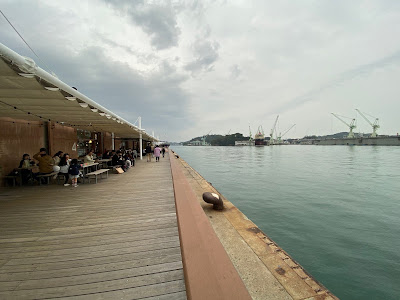




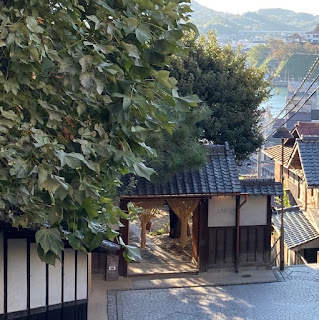

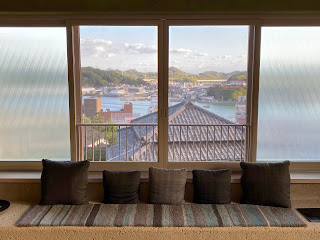








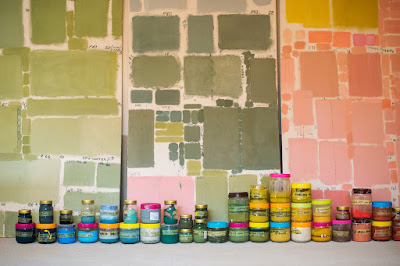










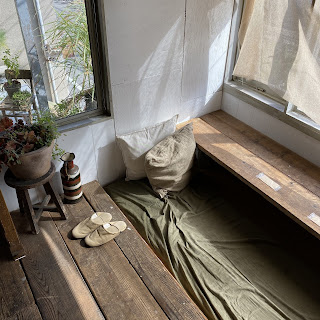






































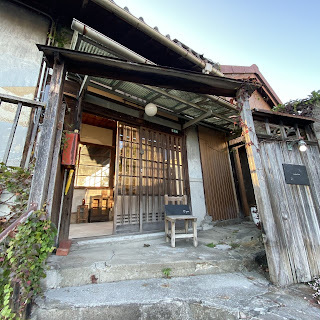



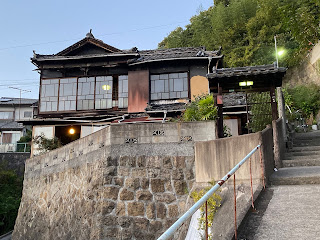





































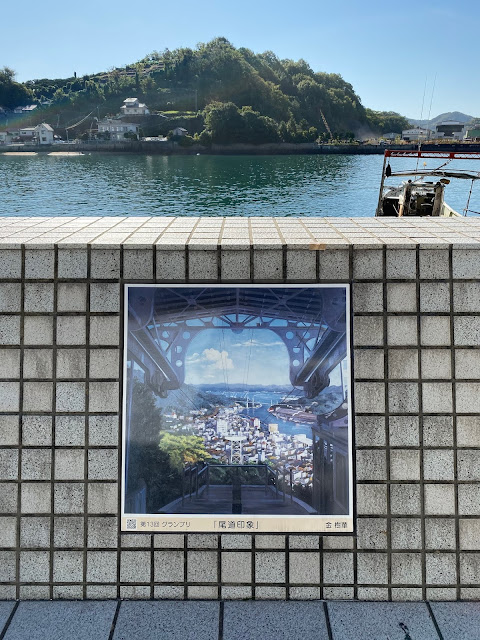












Thank you for opening my eyes to someplace I thought I knew all about. The morning light in Onomichi is THE color stuck in my head as the "beginning of a new day" from my childhood, even though I left my hometown (not far from Onomichi), when I was 18…
ReplyDeleteWonderful post, thank you for sharing. Japan from another perspective.
ReplyDeleteBeautiful photos as always. What an amazing trip. I've been wanting to go back to Japan with my kids and you've added to my inspiration...
ReplyDelete